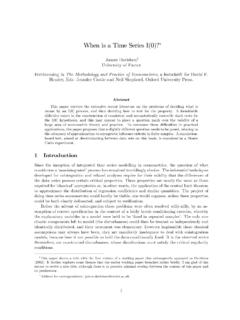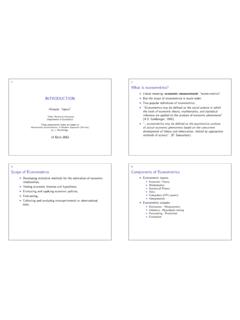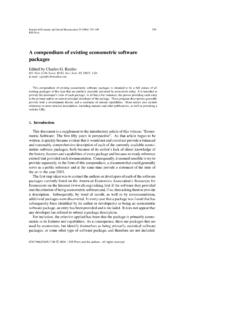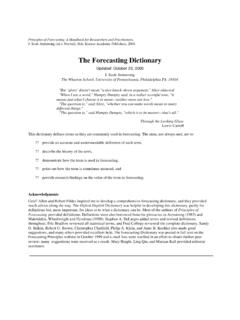Transcription of Testing for Independence Between Two Covariance …
1 Biometrika TrustTesting for Independence Between Two Covariance stationary time SeriesAuthor(s): Yongmiao HongSource: Biometrika, Vol. 83, No. 3 (Sep., 1996), pp. 615-625 Published by: Biometrika TrustStable URL: .Accessed: 22/11/2013 14:17 Your use of the JSTOR archive indicates your acceptance of the Terms & Conditions of Use, available at ..JSTOR is a not-for-profit service that helps scholars, researchers, and students discover, use, and build upon a wide range ofcontent in a trusted digital archive. We use information technology and tools to increase productivity and facilitate new formsof scholarship. For more information about JSTOR, please contact .Biometrika Trust is collaborating with JSTOR to digitize, preserve and extend access to This content downloaded from on Fri, 22 Nov 2013 14:17:02 PMAll use subject to JSTOR Terms and ConditionsBiometrika (1996), 83, 3, pp. 615-625 Printed in Great Britain Testing for Independence Between two Covariance stationary time series BY YONGMIAO HONG Department of Economics, Cornell University, Ithaca, New York 14853, SUMMARY A one-sided asymptotically normal test for Independence Between two stationary time series is proposed by first prewhitening the two time series and then basing the test on the residual cross-correlation function.
2 The test statistic is a properly standardised version of the sum of weighted squares of residual cross-correlations, with weights depending on a kernel function. Haugh's (1976) test can be viewed as a special case of our approach in the sense that it corresponds to the use of the truncated kernel. Many kernels deliver better power than Haugh's test. A simulation study shows that the new test has good power against short and long cross-correlations. Some key words: Coherency; Cross-correlation; Independence ; Kernel function; Multivariate time series . 1. INTRODUCTION Recently there has been growing interest in Testing serial dependence within a univariate time series , Chan & Tran (1992), Robinson (1991), Skaug & Tjostheim (1993a, b). In contrast, relatively few attempts have been made to test dependence Between time series . Dependence Between time series is important in multivariate time series analysis. In econ- omics, for example, elucidation of various causalities Between time series is vital to forecasting and prediction.
3 In exploiting dependence Between two Covariance stationary time series , say (Xe) and (Y,), one is often interested in Testing whether they are mutually independent. Here we propose a test for uncorrelatedness Between (Xe) and (Ye) by first prewhitening X, and Y, and then basing the test on the residual cross-correlation function. Our test statistic is a properly standardised version of the sum of weighted squares of residual cross-correl- ations, with weights depending on a kernel function. The test is asymptotically normally distributed under the null hypothesis. Haugh (1976) proposed an asymptotically x2 test based on the sum of finitely many squares of residual cross-correlations. Haugh's test can be viewed as a special case of our approach with the use of the truncated kernel. In an influential paper, Pierce (1977) used Haugh's test to investigate relationships Between a number of aggregate economic time series , and found little or no relationships Between most of the economic series .
4 From an econometric point of view, this might be partly due to low power of Haugh's test. Indeed, Geweke (1981a, b) finds that Haugh's test often has low power. In this paper, we find that many kernels deliver better power than Haugh's test or the truncated kernel based test. Within a suitable class of kernel functions, the Daniell kernel maximises the power of our test under both local and fixed alternatives. In addition, we avoid Haugh's assumption This content downloaded from on Fri, 22 Nov 2013 14:17:02 PMAll use subject to JSTOR Terms and Conditions616 YONGMIAO HONG that X, and Y, have an ARMA, autoregressive-moving average, representation, which, if misspecified, will invalidate the asymptotic distribution of the test statistic. In ? 2, we introduce the test statistic. Asymptotic normality is established in ? 3. In ?? 4 and 5, we investigate asymptotic local and global power. In ? 6, we examine finite sample performance of the new test in comparison with Haugh's (1976) test via Monte Carlo methods.
5 All mathematical proofs are available from the author upon request. 2. THE TEST STATISTIC Throughout, we impose the following assumption on X, and Y,. Assumption 1. The stochastic sequence (Xe, Y,) is a bivariate jointly stationary linear process such that 00 00 Xt =E ajut-j. Yt =E bjvt-j (t = 1, ..,N), j=O j=O where (i) (ut) and (vt) are each an identically and independently distributed sequence, with E(ut) = 0, E(vt) = 0, E(u 2) = o2, E(v2) = o2, E(u4) < oo and E(v4) < xo; (ii) (aj) and (bj) are sequences of real numbers such that ZJ% Iaj I < 0, O bjIbxI < oo with ao = = 1. Furthermore, IE0 ajzjl and IET objzjl are bounded away from zero for lzl A 1. This includes as special cases AR, autoregressive, MA, moving average, and ARMA models of finite but possibly unknown orders. For such linear processes, it is well known (Haugh, 1976, p. 379) that (Xt) and (Yt) are uncorrelated if and only if the innovations (ut) and (vt) are uncorrelated.
6 Consequently, one can test Independence Between (Xt) and (Yt) by first prewhitening Xt and Yt and then Testing Independence Between the residuals, say (ut) and (Vt). This approach, as pointed out by Haugh (1976), is much easier to handle and interpret, because it filters out the autocorrelation of Xt and Yt. Assumption 1 implies that Xt and Yt have an AR(00) representation: A(L)Xt = ut, B(L)Yt = vt, where 00 00 00 /00 A(L) = 1- ocL ,aL , B()=1-i,jLj = bjL (=L j=( j=L j=) with L a lag operator. We fit Xt by an AR(p) model. The ordinary least squares residual is At = Xt A(p),Xt(P)5 where Xt(p) = (Xt-1, .. , Xt_p)', and &(p) is the ordinary least squares estimator (N )-1 N 2p= i XEt(p)Xt(p)j E Xt(P)Xt. t=p+l t=p+l When Xt is an AR(po) process, ut will be consistent for u, if p > po. In general, there exists no po such that Ocj =0 for every j > po. Hence, we must let p = p(N) grow with N properly in order for ut to be consistent for ut.)
7 We will provide proper conditions on p and (aj) to ensure asymptotic normality of our test statistic. Similarly, we fit Yt by an AR(q) model, with the ordinary least squares residual ^t= Y- f(q)'Yt(q). This content downloaded from on Fri, 22 Nov 2013 14:17:02 PMAll use subject to JSTOR Terms and ConditionsTestingfor Independence Between time series 617 We define the residual cross-correlation function R"() R (){R "?Rv() 2, Pu(J) = vjl uo V0I1 where the residual cross- Covariance function R . N-1 ,tj+ u (j O), Ruv( J) IN1tN= A j A t+jV i< Ru (0) =N1 A U2 t,and RVV(0) = N1 Et=l vt To construct our statistics, we introduce a kernel function k satisfying the following. Assumption 2. The function k: R [-1, 1 ] is symmetric, continuous at 0 and at all but a finite number of other points, with k(O) = 1 and f k2(z) dz < 00. This includes such commonly-used kernels as the Bartlett, Daniell, Parzen, quadratic- spectral and the truncated kernels; see Priestley (1981, pp.)}
8 446-7). Our test statistic is N EJ=1-N k U(j/M)v(j) - SN(k) QN- { 2DN(k)} 12 where the smoothing parameter M = M(N) -+ oo, M/N -+0, and N-1 SN(k)= Z (1-Iij/N)k2(j/M), j=1-N N-2 DN(k) = Z (1-j jI/N)(1-((ll + 1)/N)k 4(j/M). j=2-N Under some additional conditions on k and M, we can obtain N EJ k21N k2(j/M)A2(j) - MS(k) QN {2MD(k)} 1/2 where S(k) = k2(z) dz, D(k) = k4(z) dz. Both QN and QN have the same asymptotic null distribution and power properties. We will investigate their finite sample performances by simulation methods in ? 6. Both QN and QN are essentially coherency-based tests because N-1 uv 112 = k2(j/IM)A 2v (j) j=1-N where and hereafter 11 112 = d -, and N-1 j =1-N This content downloaded from on Fri, 22 Nov 2013 14:17:02 PMAll use subject to JSTOR Terms and Conditions618 YONGMIAO HONG is a kernel estimator for coherency CU(wo) Between u, and vt, which is a measure of cross- correlation Between u, and v, in the frequency domain and has the invariance property that I Cu(a)I = I Cxy(co) I given Assumption 1 (Priestley, 1981, pp.)
9 660-2). Hong (1996) used an analogous frequency domain approach to test autocorrelation for the residual from a linear regression model that includes both lagged dependent variables and exogenous variables. Haugh (1976) proposed an asymptotic x2 test statistic M S=N ZE Puv(j). j=-M Apart from standardisation factors SN(k) and DN(k), S can be viewed as a special case of QN with the choice of the truncated kernel k(z) = 1 for I z I < 1 and k(z) = 0 for I z I > 1. As will be seen below, many choices of k yield better power than Haugh's test. On the other hand, the residuals u' and vO used by Haugh (1976) are obtained by fitting a univariate ARMA model of finite order for X, and YI respectively. As pointed out by Haugh (1976), this approach is of somewhat 'parametric nature', because the assumption of an ARMA model is rather unrealistic in practice. Model misspecification may lead to misleading conclusions because it will invalidate the asymptotic distribution of the test statistic.
10 In contrast, we approximate X, and Y, by truncated autoregressions with lag truncation numbers growing properly as the sample size increases (Berk, 1974). This ensures that ut and vt are consistent for ut and vt. 3. ASYMPTOTIC NULL DISTRIBUTION We now derive the asymptotic null distribution of QN, and thus QN. For simplicity, we assume that (ut) and (vt) are mutually independent under the null hypothesis. THEOREM 1. Suppose Assumptions 1 and 2 hold. Let M -+ oo, M/N -+0. Let p and q satisfy ( N12 (12 N ( N12 2 ( ' =12 p=oI t J14 N E m2=o /4 Ml/,4, N m f3/= M114) ~~\\M I' j=p+i l"J ~\ '~ j=q+1 If Ut is independent of vs for all t, s, then QN -+ N(0, 1) in distribution. Under the conditions on p and q, the sampling effects of o(p) and fl(p) are asymptotically irrelevant to the limiting distribution of QN. The condition p = o(N'12/Ml/4) requires that p not grow too fast; in particular, p must grow more slowly than N1/2, as M -+ oo.)))







